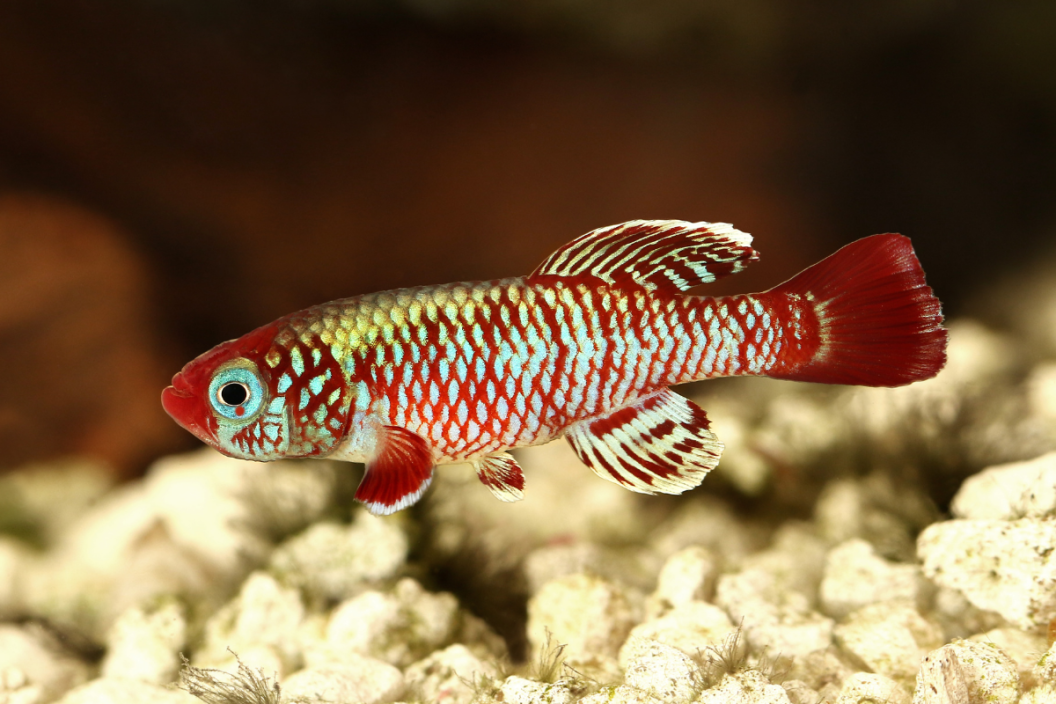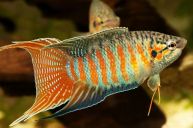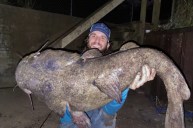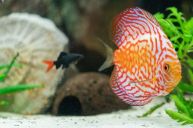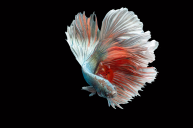What do you call a fish with no eyes? A fsh.
For years, people have speculated about the origins of these strangely vivid, short-lived little freshwater fish. There are also conspiracy theories about meteors, space aliens, and Atlantis, but we'll concentrate on the science behind this fish today.
1. Killifish Lay Their Eggs Unlike Any Other Fish
The common name "killifish" (nicknamed killies) includes the families of Aplocheilidae, Cyprinodontidae, Fundulidae, Profundulidae, and Valenciidae. Almost every warm-water climate on the planet has a killifish species, making all warm-water locations worldwide their natural habitat. The coloration and fins of the different species can vary, and they are closely related to live-bearing tooth carps. However, they lay eggs in a way that no other fish on the planet does.
The most common type of killifish live in ponds in tropical savannas in Africa, which often dry up during the dry season. Eggs are buried by the fish (bottom-spawners) during spawning season. The parents die when the pond dries up, but the eggs buried an inch or so deep in the mud live, hatching within a few hours of the rains returning, months or even a year later.
The second form is found in tropical rainforest areas, where they live in pools, swamps, and streams. Since there is a dense forest that shades the water from the sun, these fish prefer cooler temperatures (68-74 Fahrenheit) and low lighting. Fish from these habitats usually spawn by laying their eggs in the feet of floating plants.
2. Killifish Prefer Live Food, Even In Aquariums
Even in the wild, the killifish is a small fish that feeds primarily on insect larvae like mosquito larvae. Even in the aquarium, these carnivores prefer live foods but can survive on flake food supplemented with frozen foods like brine shrimp and blood worms, as well as other crustaceans. The striped panchax, also known as the Golden Wonder Killifish, is widely found in pet stores, but tank owners should be cautious when choosing tank mates. Distantly related to platies and swordtails, killifish struggle to get along with some types of fish. Neon tetras do well with killifish (provided they're big enough not to be eaten), and share the latter's love for invertebrates as food. Another species of killifish commonly found in pet stores and useful in aquariums for algae control is the flagfish, which is native to south Florida. The Golden topminnow (Fundulus chrysotus) is also native to the United States and is often available for sale at auction. If you hope to breed these fish, you'll need a separate breeding tank set up correctly.
3. They Have Specific Water Needs
They are not ideal community aquarium fish due to their nutritional requirements and preference for cooler temperatures, but this species is temperamentally compatible with most other community aquarium fish. Small fish from the genera Aphyosemion, Nothobranchius, and Cynolebias can be held in small plastic, small-gallon tanks, much like a betta fish.
Unlike a betta, special care must be taken with the water conditions. These tiny, delicate tropical fish prefer soft, acidic water and slightly lower water temperatures than most of the previously mentioned fish. If soft tap water is not available, rainwater can suffice unless it comes from a city or industrial area. Water collected from a cement roof or cistern becomes alkaline. However, aquarists should watch for any significant water changes. If you choose to pick up this fish, make sure you get a tight fitting lid, as killifish are accomplished jumpers!
4. Killifish Are Resistant To Extreme Toxicity Levels
Because of the species' genetic diversity, killifish in the Eastern United States have developed tolerance to levels of dioxins, PCBs, mercury, and other industrial chemicals up to 8,000 times higher than the historically reported lethal dose in a relatively short period of time (50-60 years). The genomes of the adapted individuals were sequenced. They discovered a shared collection of mutations among pollution-tolerant fish, many of which help to deactivate or switch off a molecular pathway responsible for a large portion of the cellular damage caused by the chemicals.
Killifish fared reasonably well in the aftermath of the Deepwater Horizon oil spill, which occurred on April 20, 2010, when an explosion occurred on the Deepwater Horizon drilling platform in the Gulf of Mexico. The explosion, which killed 11 men, caused the rig to sink and triggered a massive oil spill from the well. About 134 million gallons of oil spilled into the Gulf before it was capped three months later, making it the largest offshore oil spill in US history.
5. They Are 'Annual Fish' Due To Their Short Lives
These species are sometimes referred to as annual fish or annual killifish because they have very short life cycles and only live for one egg-laying season. Like many guppies, they have vivid, vibrant colors and beautiful finnage but have a very short lifespan. They are attractive for a short time and then begin to fade, wither, and die. It is not the hobbyist's fault that this occurs. Even in ideal circumstances, these fish are designed to grow quickly, have offspring, and die. This fish has a short lifespan, and the fact that there is no dry season in the aquarium doesn't change that. However, some pet stores do sell a non-annual variety, which is popular due to its longer lifespan. This variety does grow more slowly, so keep that in mind.
Tell us about your favorite aquarium fish on the Wide Open Pets Facebook page!
